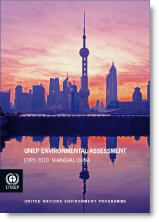|
|


ADVERTISEMENT
Buy Your own advertising
spaces!
.
Download Adobe Acrobat Reader to open [PDF] files.
Recent Visitors
UNEP Environmental Assessment Expo 2010
2009. 7 September
It aims to provide an objective appraisal of the efforts of Shanghai in improving its environmental quality and organizing an environment-friendly Expo. Measures and achievements are documented and analyzed and recommendations are made to assist the Shanghai municipal government to strengthen environmental initiatives for and beyond the Expo 2010. (asiaing.com)
This report is an independent assessment of the environmental initiatives taken by Shanghai in its preparation for the World Exposition in 2010 (Expo 2010) in Shanghai, China.
(asiaing.com)
This report is an independent assessment of the environmental initiatives taken by Shanghai in its preparation for the World Exposition in 2010 (Expo 2010) in Shanghai, China.
EXECUTIVE SUMMARY
This report is an assessment of Shanghai’s environmental initiatives in its preparation for the Expo 2010. It covers the general greening efforts of the city since 2000, as well as those specifically designed for the Expo. Measures and achievements are documented and analyzed. Areas for improvement are identified and recommendations are made.
The organizer has chosen the theme, “Better City, Better Life”, to promote the Green Expo concept. The idea of a Green Expo aims at not only benefiting the 70 million expected visitors, but also leaving a green legacy for the citizens of Shanghai and contributing to worldwide initiatives of making cities more sustainable.
The report discusses Shanghai’s efforts on the nine key aspects: air quality, transport, energy, solid waste, water, green coverage, protected areas, climate neutrality, the Expo Site and public participation so far.Air Quality: Shanghai’s rapid development in the last decade did not make air pollution worse. On the contrary, for the first time in the city’s history, economic development was made possible with the ambient concentration of air pollutants reduced or at least stabilized. The success of Shanghai in de-coupling growth with worsening pollution is considered. Recommendations are made on strengthening regional cooperation, improving monitoring standards and expanding the scope of monitoring air pollutants.
Transport: This chapter discusses the public transportation prioritization strategy of Shanghai. It examines a) the development of rapid transit systems, b) the strengthening of public bus networks and the experiments of new energy vehicles, c) the innovative vehicle license auctioning mechanism, and d) the tightening of vehicle emissions. Also highlighted are the construction of a world-class rapid transit network with over 400 kilometers of tracks built in twenty years as well as the introduction and use of new energy-efficient vehicles.
Energy: Shanghai’s reliance on coal is still prominent despite a decrease from 64 per cent to 51 per cent from 2001 to 2007. The report discusses and affirms the improvements made in the energy structure and the efforts made in increasing energy efficiency. It encourages Shanghai to keep scaling up renewable energies as demonstrated in its setting up of China’s largest building-integrated solar power PV plant and offshore wind farm, further improving energy efficiency and enhancing demand-side management.
Waste: The report points out that while safe disposal seems to be the foundation of Shanghai’s waste strategy there is a need to develop a comprehensive waste reduction strategy for the city and the Expo, to address the environmental impact resulting from under-capacity and to motivate the public as part of the solution.
Water: Shanghai achieved significant improvement in ensuring a safe and stable drinking water supply, stepping up its measures in treating sewage and cleaning up its polluted waterways. While acknowledging the scale, the intention and positive impact of these measures, the report points out the need to tackle the nitrification of the river systems. Regional cooperation is necessary in order to fundamentally turnaround the trend of river pollution.
Green Coverage and Protected Areas: Between 2000 and 2008 – in less than a decade -- Shanghai has enjoyed three times more of urban green areas per capita and four times more total forest coverage. The protection of environmentally-sensitive and high conservation areas are also discussed in this chapter. Recommendations are made to consolidate the environmental gains of these efforts.
Expo Site: Sustainability and environmental concerns are taken into account in the Expo site and its venues. This chapter documents the green concepts and technologies extensively used in the newly built landmarks, the national pavilions and the Urban Best Practices Area.
The report discusses the issue of climate neutrality and recommends the organizer to seriously look at achieving a low-carbon Expo. Finally, public participation is examined and it is recommended that the organizers develop a pro-active communication plan on the green efforts for the Expo, activate NGO participation and promote green citizenship for the residents.
Download UNEP Environmental Assessment Expo 2010 Shanghai, China
PDF format, 12MB, 149Pages.
UNEP AND EXPO 2010
UNEP’s involvement with Expo 2010 in Shanghai started in 2004 when Klaus Toepfer, the UNEP Executive Director at the time, became an environment advisor to the Mayor of Shanghai. In May 2007, the current Executive Director of UNEP, Achim Steiner, paid a visit to the Expo Site. A series of discussions and visits led to the signing of a Memorandum of Understanding in March 2009 between the Bureau of Shanghai World Expo Coordination and UNEP.
UNEP agreed to support the greening of Expo 2010 in the following areas:
- Provision of expertise and support for developing a ‘Green Guide’ for 2010 Expo;
- Conducting an environmental assessment of the preparations of Expo 2010 and releasing a report of the assessment;
- Jointly organizing with the Expo Bureau a high level forum during Expo 2010;
- Facilitating an exchange of views between the Expo Bureau and international NGOs on Expo related issues
This Expo 2010 assessment is the third environmental assessment of a mass event in China and follows two previous UNEP reports on the Beijing 2008 Olympics Games (published in November 2007 and February 2009 respectively).
Source: www.asiaing.com

